

Checker shadow illusion. The checker shadow illusion is an optical illusion published by Edward H.

Adelson, Professor of Vision Science at MIT in 1995.[1] The image depicts a checkerboard with light and dark squares. The optical illusion is that the area of the image labeled A appears to be a darker color than the area of the image labeled B. However, they are actually exactly the same color. This can be proven using the following methods:[2] Opening the illusion in an image editing program and using the eyedropper tool to verify that the colors are the sameIsolating the squares.
See also[edit] References[edit] External links[edit] CIECAM02. Observing field model.
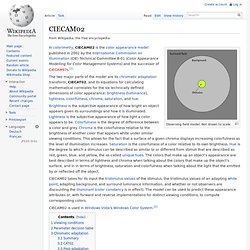
Not drawn to scale. In colorimetry, CIECAM02 is the color appearance model published in 2002 by the International Commission on Illumination (CIE) Technical Committee 8-01 (Color Appearance Modelling for Color Management Systems) and the successor of CIECAM97s.[1] CIECAM02 takes for its input the tristimulus values of the stimulus, the tristimulus values of an adapting white point, adapting background, and surround luminance information, and whether or not observers are discounting the illuminant (color constancy is in effect). The model can be used to predict these appearance attributes or, with forward and reverse implementations for distinct viewing conditions, to compute corresponding colors. CIECAM02 is used in Windows Vista's Windows Color System.[2] Viewing conditions[edit] The inner circle is the stimulus, from which the tristimulus values should be measured in CIE XYZ using the 2° standard observer. Parameter decision table[edit] Chromatic adaptation[edit]
Recursive definition. Four stages in the construction of a Koch snowflake.

As with many other fractals, the stages are obtained via a recursive definition. A recursive definition (or inductive definition) in mathematical logic and computer science is used to define an object in terms of itself (Aczel 1978:740ff). A recursive definition of a function defines values of the functions for some inputs in terms of the values of the same function for other inputs. For example, the factorial function n! Is defined by the rules (n+1)! This definition is valid for all n, because the recursion eventually reaches the base case of 0. That such a definition indeed defines a function can be proved by induction. Tuple. In mathematics, computer science, linguistics,[1] and philosophy[2] a tuple is an ordered list of elements.
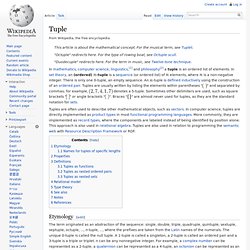
In set theory, an (ordered) -tuple is a sequence (or ordered list) of elements, where is a non-negative integer. There is only one 0-tuple, an empty sequence. -tuple is defined inductively using the construction of an ordered pair. " and separated by commas; for example, denotes a 5-tuple. " or angle brackets " ". Etymology[edit] The term originated as an abstraction of the sequence: single, double, triple, quadruple, quintuple, sextuple, septuple, octuple, ..., n‑tuple, ..., where the prefixes are taken from the Latin names of the numerals.
Although these uses treat ‑tuple as the suffix, the original suffix was ‑ple as in "triple" (three-fold) or "decuple" (ten‑fold). Names for tuples of specific lengths[edit] Color model. A color model is an abstract mathematical model describing the way colors can be represented as tuples of numbers, typically as three or four values or color components.
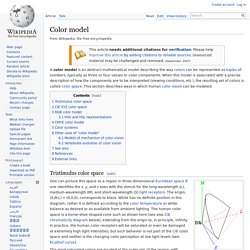
When this model is associated with a precise description of how the components are to be interpreted (viewing conditions, etc.), the resulting set of colors is called color space. This section describes ways in which human color vision can be modeled. Lightness. Three hues in the Munsell color model.
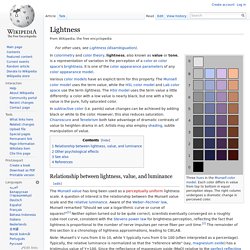
Each color differs in value from top to bottom in equal perception steps. Pantone. Pantone Inc. is a corporation headquartered in Carlstadt, New Jersey.[1] The company is best known for its Pantone Matching System (PMS), a proprietary color space used in a variety of industries, primarily printing, though sometimes in the manufacture of colored paint, fabric, and plastics.

In October 2007, X-Rite Inc, a supplier of color measurement instruments and software, purchased Pantone Inc. for $180 million.[2] Overview[edit] The company's primary products include the Pantone Guides, which consist of a large number of small (approximately 6×2 inches or 15×5 cm) thin cardboard sheets, printed on one side with a series of related color swatches and then bound into a small "fan deck". For instance, a particular "page" might contain a number of yellows of varying tints. Color space. A comparison of the chromaticities enclosed by some color spaces.
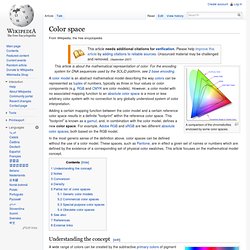
A color model is an abstract mathematical model describing the way colors can be represented as tuples of numbers, typically as three or four values or color components (e.g. RGB and CMYK are color models). However, a color model with no associated mapping function to an absolute color space is a more or less arbitrary color system with no connection to any globally understood system of color interpretation.